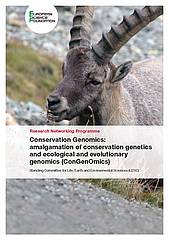Summary
Conservation Genomics: amalgamation of conservation genetics and ecological and evolutionary genomics (ConGenOmics). Conservation genomics is a new field that is developing out of the merging of conservation genetics with ecological and evolutionary genomics. By using the latest genomic technologies conservation genomics is concentrating on :
i) applying genome-wide markers to reliable estimate demographic and genetic parameters in a conservation context,
ii) applying gene-expression tools to study the mechanisms behind important conservation genetic processes, like inbreeding depression, and
iii) using metagenomic approaches to develop from population level approaches to species and community level assessments. The field has been designated by the former ESF-CONGEN networking programme as ―the future of conservation genetics.
At the same time, it was acknowledged that several challenges will have to be met, including:
i) the transfer of genomic tools to non-model, threatened species,
ii) the transfer of knowledge from genomic oriented labs to conservation oriented labs,
iii) the equal sharing of genomic resources and knowledge between European labs, and
iv) the design of multidisciplinary approaches to data management and analyses of the vast amounts of genomic data on threatened species likely to become available in the near future.
The custodial responsibility to conserve biodiversity, including genetic variation within populations and species requires a pan_European approach. The CONGENOMICS programme aims to deliver a European platform for exchange of knowledge and facilities in the context of conservation genomics. By organizing workshops, summer schools, collaborative expert meetings and establishing a website and an exchange program at pan-European level, CONGENOMICS wants to be instrumental in the further development of the field of conservation genomics, and wants to aid less knowledgeable and affluent countries and research groups to be fully part of the new and exciting developments in this field. By adding a global dimension the programme also aims at exchanging knowledge between Europe and the USA in this respect.
Duration
Five years, from June 2011 to June 2016
External Web page
More information is available on the external web page.


